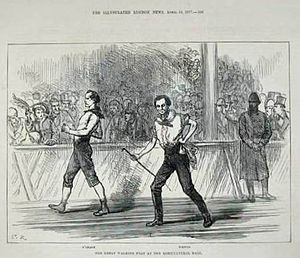
6 Day Race
The 6-Day Race became a standard footrace distance in the 1870s and was a popular form of entertainment with up to 70,000 paying visitors during such a Pedestrians event. However the widespread use of the bicycle from 1890 caused it to be replaced as spectator sport by cycle races of the same duration. It was in two forms: strict "heel-and-toe" racewalking, or "go-as-you-please" combination of walking, jogging, running.
History
In 1773, Foster Powell, of England, started the focus on walking/running for six days when he walked from London to York and back, 400 miles (640 km), in six days and is considered the “Father of the Six-Day Race.” The first six-day race in history was put on by P.T. Barnum of circus fame, in his New York City Hippodrome on March 1, 1875, between Edward Payson Weston and "Professor" John R. Judd. Weston won with 431 miles (694 km) to Judd's 222 miles (357 km). The second race was held November 15, 1875, between Weston and Daniel O'Leary in Chicago, Illinois, with O'Leary emerging victorious with 503 miles (810 km) and Weston finished with 451 miles (726 km). On March 6, 1876, the first six-day race was held in England, inside the Royal Agricultural Hall, in Islington, London, won by Weston with 450 miles (720 km). His nearest competitor, W. Newman finished with 190 miles (310 km). The first six-day race between women was held in 1876, in Chicago Illinois, between Bertha Von Hillern and Mary Marshall. Marshal won with 233.9 miles (376.4 km) to 231.5 miles (372.6 km).

In a re-match between Weston and O'Leary in 1877, O'Leary was victorious again and the excitement created enough interest for Sir John Dugdale Astley, a British Member of Parliament, to inaugurate a series of 6 day races to determine the "Long distance Champion of The World". These became known as the "Astley Belt" races and cash prizes were offered. O'Leary won the first two and was thwarted by Charles Rowell in his quest for three in a row. Weston won the fourth, setting a record of 550 miles (890 km) and Rowell won the final three multiday races to permanently keep the Astley Belt.
The 1879 World Championship
Results
| P. | Athlete | Nationality | Miles | Km |
|---|---|---|---|---|
| 1 | George Guyon |
|
4801⁄4 | 772.89 |
| 2 | Frederick Krohne |
|
461 | 742 |
| 3 | John P. Colston |
|
4521⁄5 | 727.5 |
| 4 | Charles Faber |
|
4501⁄8 | 724.6 |
| 5 | Ben Curran |
|
4381⁄4 | 705.1 |
| 6 | Peter N. Campana |
|
4011⁄3 | 645.8 |
| 7 | W.H. Davis |
|
225 | 362.1 |
Intermediate results:
- 24 hours: Guyon 105 miles; Faber 100; Byrne 95; Washington 93.5; Krohne 91; Campana 86; Colston 82; Curran 80; Urann 78; Kent 75; Forrester 67.5; Davis 60. Retired: Cotton (60) and Stark (52).
- 48 hours: Guyon 187 miles; Faber 178; Krohne 172; Campana 165; Washington 161; Curran 159; Colston 150; Kent 142; Forrester 118; Davis 102. Retired: Byrne (104) and Urann.
- 72 hours: Guyon 267 miles; Krohne 254; Faber 250; Campana 236; Colston 226; Curran 224; Washington 213; Kent 211; Davis 152
- 96 hours: Guyon 345 miles; Krohne 335; Faber 314; Colston 300; Curran 296; Campana 292; Davis 188.
In 1880, Frank Hart set a new record of 565 miles (909 km) earning $17,000 dollars, a fortune at the time.
Between 26 November and 1 December 1888, George Littlewood of Sheffield, England, created a new world record of 623 miles 1,320 yards—a record that wasn't beaten for 96 years.
By the early 1890s the six-day races were in decline and no longer drawing the public or offering large prizes. They were discontinued by 1903 because local laws were passed to disallow amusement events lasting more than a day.
It wasn't until Don Choi hosted a 6-day race on July 4, 1980. at Woodside California that interest began to grow again. Briton Mike Newton became the first man to cover 500 miles/800 km in a modern 6-day race at Nottingham in November 1981. In 1982, Tom O'Reilly took the 6-day total to 576 miles/927 km. In 1984 Yiannis Kouros twice ran over 1,022 km (635 mi) setting a new world record that would stand until 2005 when he broke his own record again with 1,036 km (644 mi) at the Cliff Young Australian 6-day race in Colac, Australia.
The first women's 6-day race took place in 1876 and was won by May Marshall with 233 miles (375 km). Sandra Barwick set the current women's World Best of 883.631 kilometres (549.063 mi) in November 1990 at the Campbelltown Australian 6 Day Race.
Current 6-Day Races
- 6 Days in The Dome
- 6 Jours de France
- Across the Years
- Australian 6 Day Race
- Antibes 6 Day Race (Now known as 6 Jours de France)
- Arizona 6 Day
- Athens 6 Day Race
- British Ultra Fest
- No Finish Line 6 Day
- 6 DAYS UMF Italian UltraMarathon Festival
- Self-Transcendence 6 day
- South Africa 6 Day Circuit
- Three Days At The Fair (2017
- Unixsport 6 Day International Ultramarathon Challenge
- Hallsberg 6 Day (Sweden)
- Viadal Ultra Six Days (Sweden)
External links
- Davy Crockett The Six-Day Race
- Andy Milroy Yiannis Kouros – The Making of a Legend
- Andy Milroy The events and performances that have shaped ultrarunning
- Kelly Collins – The History of Multiday Running
- 6 Jours D'Antibes.com
- Self-Transcendence
- Erkrath
- Multiday races
- ULTRAmarathonRunning.com Global Ultramarathon Races & Events Calendar
- King of the Peds
Literature
- Ultramarathoning: The Next Challenge, by Tom Osler and Ed Dodd
- Ultrarunning magazine
- Multiday Running Magazine
- King of the Peds, by P.S. Marshall